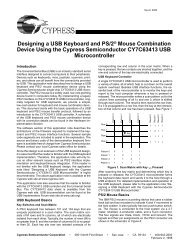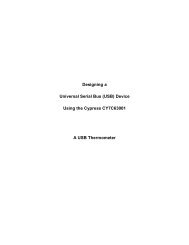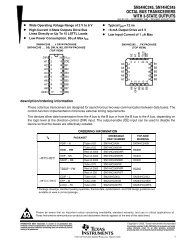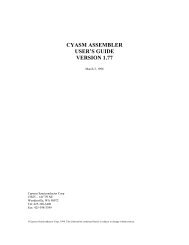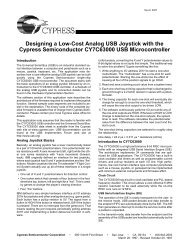Ergonomic Design of A Portable Musical Instrument - New Interfaces ...
Ergonomic Design of A Portable Musical Instrument - New Interfaces ...
Ergonomic Design of A Portable Musical Instrument - New Interfaces ...
Create successful ePaper yourself
Turn your PDF publications into a flip-book with our unique Google optimized e-Paper software.
Proceedings <strong>of</strong> the 2003 Conference on <strong>New</strong> <strong>Interfaces</strong> for <strong>Musical</strong> Expression (NIME-03), Montreal, Canadaapproach for expressiveness maximization. The positioning <strong>of</strong>the twisting pivot was also experimented and determinedusing the foam mockups. The pivot was first positioned at thecenter <strong>of</strong> the device, which worked fine for the cylindricalshape. However, having the pivot at the center <strong>of</strong> therectangular mockups required large motions <strong>of</strong> the forearms,which could lead to elbow motions that disturb surroundingpeople. The problem was solved by shifting the pivot towardthe wrists.Figure 5. Foam mockups for initial instrument design. Theglove is placed for size reference.For the cylindrical shape, it was discovered that the handsconform too nicely to wrap around it such that it left thefingers with little freedom to move (see Figure 6).Figure 7. In a grip using fingertips, thumbs and some fingersmust always remain on the instrument to support it.Figure 6. Having no free space between the instrument andthe fingers limits the freedom <strong>of</strong> finger motion.The narrow rectangle relied on the fingers and thumb forsupporting the instrument. As a consequence, both <strong>of</strong> thethumbs as well as two fingers from each hand had to stay onthe instrument for stable support. This greatly inhibited theirfreedom for performance (see Figure 7).The square shape was selected at the end as its wide shapeallowed for the user’s palms to support the instrument withouthindering the dexterity <strong>of</strong> thumbs and fingers (see Figure 8).The result <strong>of</strong>the experiment shows that round shape does notnecessarily make a device ergonomic. Various ways <strong>of</strong>grasping are listed and described in books by Cutkosky [3]and MacKenzie and Iberall [6].3.2 Sensor Selection and LayoutControlling a timbral effect parameter by twisting theinstrument was one <strong>of</strong> the featured ideas <strong>of</strong> the design.Twisting and bending are motions that could be easily appliedby the performer’s wrists. Therefore, making use <strong>of</strong> that motionwas perfectly suited to represent our ergonomics considerationFigure 8. Palms are used to support the instrument, leavingthe thumbs and fingers free to move.Another expression parameter was to be controlled with thesqueezing force between the two halves <strong>of</strong> the instrument. Thetwist and squeeze sensors were integrated in one unit. Therotary potentiometer for sensing the twist was suspended on alinear slider that allows it to translate in the direction parallelto its rotating axis. An FSR was installed behind thepotentiometer via a rubber cushion to sense the squeeze.<strong>Design</strong> <strong>of</strong> other input devices was done by analyses andmatching <strong>of</strong> the task, device characteristics, and humanergonomics all together. Predicted interaction frequency aswell as the required signal output (continuous or discrete)were listed out for various control parameters (see Table). Forexample, melody pitch changes are required much morefrequently than scale change. Properties <strong>of</strong> various inputdevices such as the output signal types and the time requiredNIME03-79
Proceedings <strong>of</strong> the 2003 Conference on <strong>New</strong> <strong>Interfaces</strong> for <strong>Musical</strong> Expression (NIME-03), Montreal, Canadato manipulate them were also listed. The list was used toidentify the potential couplings <strong>of</strong> control parameters andsensors.Table 1. Body parts, control parameters, and sensors werematched by analyzing their characteristics.Final selection and physical layout <strong>of</strong> these input deviceson the instrument were done through an experiment to movethumbs and fingers in every possible way on the foammockup. The objective was to discover how to extractmaximum expressiveness out <strong>of</strong> the hands. The range andspeed <strong>of</strong> motion aswell asforce and control involved wereanalysed. Level <strong>of</strong> comfort was another factor that was tested.The layout determination also considered maintaining enoughcomfortable room for the thumbs and fingers to rest. It is worthkeeping in mind that fingers are good at flexing and extendingbut they are not so finely controllable nor forceful atabduction or adduction, especially when they are bent. Thereare also slight but noteworthy differences in the dexterityamong the four fingers. The index finger, for example, hasmuch more independence in motion compared to the otherthree fingers. Meanwhile, a thumb can exhibit a variety <strong>of</strong>complex motions unrivaled by fingers. Such facts about handscan also be obtained from literature by, for example, Kaplan [4]and Wilson [16], but the effectiveness <strong>of</strong> mockupexperimentation cannot be completely replaced by readingonly. However, while experiments can reveal what one can do,literature on ergonomics such as [1] by Cacha can providemore information about what is good or bad for the hands inlong term ergonomics so that injuries can be prevented.Here are some examples from the resulting design. There aretwo sliders positioned diagonally on the thumb side <strong>of</strong> thedevice. They are assigned for key and chord selection. Anotherslider is placed lower on the device for style change, where it isnot as accessible, since it will not be used as frequently as thetwo others (see Figure 9). The chord/key/style settings changeonly when an activation button is pressed. This allows the userto control the sliders during performance in preparation for afuture change without interfering the ongoing performance.The right fingers do the melodic performance by pressingbuttons (see Figure 10). Fingers are good for selecting andpressing buttons. They are also quite capable <strong>of</strong> varyingpressure on each finger if needed. Fingers on the left hand wereused to trigger effects-selection toggle switches.4. SYSTEM CONFIGURATIONSensor information from the Bento-Box was collected by anAtmel ATMega 163 microcontroller and was sent to a desktopcomputer as MIDI data. Pd [8] was employed to process thedata and generate sound with plugins created from SynthesisToolKit (STK) physical models [2]. C++ plugins were alsoemployed to ease signal processing (see Figure 11).Figure 9. The Bento-Box (150mmx150mmx45mm, 526g)Frequently used controllers are ergonomically placed.Figure 10. Noiseless buttons for playing melody.Figure 11. System configuration5. SETUP ALTERATIONOnce the entire setup was built according to the initialdesign, some alterations were made in the assignment <strong>of</strong>sensors to effect parameters after some experimentation.Certain sensors turned out to be ergonomically difficult touse. Some modes <strong>of</strong> control were avoided because they wereconfusing for the user. Furthermore, less-used functions werereplaced by more desired functions for a richer musicalexperience.5.1 Initial SetupThe initial setup was as follows (please refer to Figures 12and 13). There were two rows <strong>of</strong> eight buttons each for the rightfingers, each assigned to individual notes. The note assignedto these buttons changed depending on the style and keysetups, which were selected by sliders operated by the rightthumb. The style slider was located lower than the key slider,NIME03-80
Proceedings <strong>of</strong> the 2003 Conference on <strong>New</strong> <strong>Interfaces</strong> for <strong>Musical</strong> Expression (NIME-03), Montreal, Canadawhich was positioned diagonally at the top <strong>of</strong> the back rightside (Back refers to the thumb side <strong>of</strong> the instrument, whichfaces toward the user). There isachord selection slider, whichwas planned to automatically accompany the melodyperformed, on the left back side symmetrical to the keyselection slider. The style, key, and chord changes are only tooccur when one <strong>of</strong> the two small red activation buttons,installed on both right and left just below the two symmetricalsliders, are pressed. A large black button next to the activationbutton for the right thumb was to be a scale-reset button whichenables the user to instantly change the note designation forthe right finger buttons to achromatic scale. Symmetrically onthe left is an FSR for a volume effect. It was to decrease volumeas it was pressed.Figure 12. Thumb (back) side schematic <strong>of</strong> the initial setupOn the front side, there are four three-way momentary toggleswitches for the left fingers. Each <strong>of</strong> these were to be assigned asound effect, and used to select a sensor for controlling theeffect; either the twist or the squeeze sensors at the center <strong>of</strong>the device.Figure 13. Finger (front) side schematic <strong>of</strong> the initial setup5.2 Altered SetupThese four toggle switches turned out to be difficult tooperate with fingers. They had to be pulled toward or pushedaway from the palm, and the latter was especially difficult. Theswitches were also rather stiff. These switches were notemployed in the final setup since it was found to be veryconfusing for the performer to alter the effects assigned tovarious sensors. Avoiding modes like this is recommended inHCI design ingeneral [9]. The left fingers can instead be usedto play notes like the right fingers by installing more buttons.The key and chord selectors were not used during test trials.The key selector was left unused as no key change took placeduring performance. The chord selector was not needed sincethe melody buttons, controlled by the right fingers, could playchords. Instead <strong>of</strong> the initially intended applications, thesetwo sliders were assigned to control more effect parameters.As the result <strong>of</strong> the above changes, the two activationbuttons were no longer necessary. Furthermore, the scale-resetbutton and the volume effect controller were never used. Theseinput devices were not used in the final setup.6. FINDINGS AND FUTUREIMPROVEMENTSFuture improvements are suggested from the experience <strong>of</strong>playing with the finalized setup. The musical setup,employing the style selection slider and numerous effectcontrols, was quite a success. Generally, more feedback is idealin both physical and visual forms. Some mechanicalimprovement is also required for comfort and robustness. Inaddition, device-specific functional consideration wouldimprove the quality <strong>of</strong> performing experience. Furthermore,there is the engineering task to make it a real portable device.6.1 FeedbackVisual information feedback is necessary to show the styleand key setup as well as any other parameters that may needindication. (Although the key control was eliminated in thefinal setup, it would still be a necessary function.) This wouldsimply require a small LCD on the backside <strong>of</strong> the instrument.Force feedback would be useful in some <strong>of</strong> the continuouseffect controls. Passive feedback by springs might besufficient for the application. Such a system can also helpbring the effect control back to the neutral position.The importance <strong>of</strong> tactile feedback was confirmed whenoperating the note buttons on the blind side <strong>of</strong> the instrument.For example, it would be very difficult to locate buttons ifthey were all flat. Alternatively, hand location with respect tothe instrument may be realized by placing an indexing featurewhere the palm touches the instrument.6.2 Mechanical improvementThe twisting pivot, which connected the right and lefthalves <strong>of</strong> the instrument, had a robustness concern. It was arotary potentiometer and was not necessarily designed to bearload. A load isolation mechanism must be introduced toimprove the structural reliability <strong>of</strong> the instrument.The square Plexiglas construction is uncomfortable to hold.The material and the fabrication method constrained theinstrument surfaces to be designed flat. Three-dimensionalfreeform manufacturing capability would greatly increasedesign freedom and the resulting ergonomics.Sliders also had some usability problems. There wasfrictional resistance making the operation difficult when fastcontrol was desired. The linear motion was also not veryergonomic for the thumbs. Instead, a curved pressure-sensitivetouch-pad would be a nice replacement as there would bevirtually no frictional resistance upon operation. It can alsomake better use <strong>of</strong> the dexterity <strong>of</strong> thumbs by added sensingdimensions: two- dimensional coordinates and verticalpressure.6.3 Device-Specific DevelopmentCurrently, the various sound effects are arbitrarily assignedto the sensors on the instrument. As a result, the physicalmotion <strong>of</strong> the performer does not correlate with the resultingeffects in any intuitive way. Hence, custom developed effectsthat relate intuitively to the physical actions are desired. Forexample, sound may be ”twisted” or “squeezed” by skillfulmulti-speaker output system.NIME03-81
Proceedings <strong>of</strong> the 2003 Conference on <strong>New</strong> <strong>Interfaces</strong> for <strong>Musical</strong> Expression (NIME-03), Montreal, Canada6.4 Stand-aloneHere, the system required three separate components; theBento-Box as the controller, a micro controller for dataacquisition, and a desktop computer for sound generation. Itwould be desirable to integrate all <strong>of</strong> it so that everything willbe enclosed in a Bento-Box size package for true portability.7. CONCLUSIONA prototype for a portable handheld electronic musicalinstrument was successfully built. Its unique style selectioncapability allows the user to easily perform a variety <strong>of</strong> styles<strong>of</strong> music, which would otherwise have been difficult to learn.The initial motivation was to create a personal instrument tobe heard only by the performer. However, the resultinginstrument, with a rich capability to control variousinteresting sound effects, is fit for performing out loud alongwith other musicians. The design was done with mockupiterations and functional and ergonomic analyses, and has ledto many interesting findings. The experimentation with thecompleted setup has inspired further improvements.8. ACKNOWLEDGMENTSIwould like to thank my project teammates Seth Nickell andKatia Zarrillo for the collaboration, the class teaching team(Pr<strong>of</strong>essors Bill Verplank and Max Mathews, TA’s MichaelGurevich and Wendy Ju) for giving me the opportunity, andPr<strong>of</strong>essor Mark Cutkosky and Weston Griffin for support inwriting.9. REFERENCES[1] Cacha, C.A. <strong>Ergonomic</strong>s and Safety in Hand Tool <strong>Design</strong>.CRC Press LCC, Florida, 1999.[2] Cook, P.R. Synthesis ToolKit Algorithms and<strong>Instrument</strong>s.http://www.cs.princeton.edu/~prc/STKAlgorithms.html[3] Cutkosky, M.R. Robotic Grasping and Fine Manipulation.Kluwer Academic Publishers, Massachusetts, 1985.[4] Kaplan, E.G. Functional and Surgical Anatomy <strong>of</strong> theHand. J. B. Lippincott Company, Philadelphia andMontreal, 1965.[5] Kelley, T., and Littman, J. The Art <strong>of</strong> Innovation.Doubleday, <strong>New</strong> York, 2001.[6] MacKenzie, C.L. and Iberall, T. The Grasping Hand.Elsevier Science B.V., Amsterdam, 1994.[7] Nintendo Gameboy. http://www.gameboy.com/[8] Puckette, M. Pd download site.http://crca.ucsd.edu/~msp/s<strong>of</strong>tware.html[9] Raskin, J. The Humane Interface: <strong>New</strong> Directions for<strong>Design</strong>ing Interactive Systems. Addison-Wesley,Massachusetts, 2000.[10] Sony Walkman. http://www.sony.net/Products/walkman/[11] Verplank, B., Sapp, C., and Mathews, M. A Course onControllers. Proceedings <strong>of</strong> NIME (Seattle, Washington,USA April 2001)[12] Waisvisz, M. “The hands, a set <strong>of</strong> remote midicontrollers,''in Proc. Int. Computer Music Conf.(ICMC'85), pp. 313-318, 1985[13] Weinberg, G., Lackner, T., and Jay, J. "The <strong>Musical</strong>Fireflies - Learning About Mathematical Patterns in MusicThrough Expression and Play". Proceedings <strong>of</strong> XIIColloquium on <strong>Musical</strong> Informatics 2000. A'quila Italy.[14] Weinberg, G., Orth M., and Russo P. "The Embroidered<strong>Musical</strong> Ball: A Squeezable <strong>Instrument</strong> for ExpressivePerformance," Proceedings <strong>of</strong> CHI 2000. The Hague: ACMPress.[15] Weinberg, G., Aimi, R., and Jennings, K. "The BeatbugNetwork – A Rhythmic System for Interdependent GroupCollaboration." Proceedings <strong>of</strong> NIME 2002. Dublin: MLE.[16] Wilson, Frank R. The Hand: how its use shapes the brain,language, and human culture. Pantheon Books, <strong>New</strong> York,1998.NIME03-82



